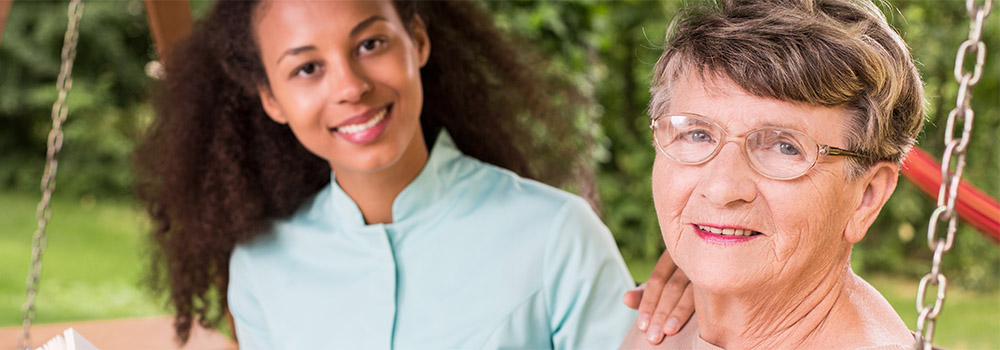Should You Rely on Family Caregivers or Hire a Professional?
This is a question that may weigh on families, particularly as loved ones age. Before trying to decide what is best for your unique situation, let’s talk about some key differences between family caregivers and professional caregivers.
Most family caregivers volunteer their time, without pay, to help with the care needs of a loved one. Family caregivers aim to provide long-lasting support and relief to elderly loved ones. Their goal is to ease distress and encourage comfort. Despite juggling numerous responsibilities, like work and children, family caregivers manage their duties in order to provide the necessary care to a senior loved one.

A professional caregiver is hired to provide care for a care recipient. These caregivers can provide medical or non-medical care in the home or a facility. Professional caregivers deeply believe in their role of providing compassionate service to seniors during their last few weeks, months or years of life. Given their dedication to the profession, many caregivers dutifully serve in the elder care field for many years.
Making a Plan for Future Caregiving Needs
According to a report from the Department of Health and Human Services (HHS), there were 46 million American seniors aged 65 and older in 2014. The number of seniors in America could reach almost 100 million by 2060. ¹ Based on the projected growth of this demographic, the demand for senior caregiving may skyrocket over the next few decades as well. With this in mind, it is a good idea to think ahead about what care you may require in the future and set up a care plan that will fulfill your needs.
Caregivers play an integral role in seniors’ health and safety. There are different types of caregiving structures. Some older adults might have a mix of family and professional caregivers, while others might rely on just one of the two.
Professional caregivers provide both medical and non-medical support. Family caregivers can learn some in-home medical support, but typically only help with daily personal tasks. Your care should reflect your needs and prioritize your safety. A good aging-in-place care plan designates caregivers and includes helpful tools, such as a medical alert system or P.E.T. (personal emergency transmitter), to make you feel more secure.
What Does a Family Caregiver Do?
Most people imagine caregivers as professionals who are paid to provide in-home care for seniors. This understanding of caregiving often fails to include an important part of senior care: family caregivers. A family caregiver is a family member or loved one who provides at-home care. This type of care is typically unpaid.
AARP reports in a study that in 2015 more than 34 million Americans were unpaid caregivers to loved ones above the age of 50. The polled caregivers had been in their care roles for approximately four years, averaging about 24 hours of care per week.
The duties of professional and family caregivers often overlap, but typically only professional caregivers are paid. A family caregiver might be more involved in the senior’s financial management, scheduling, communication, and care plan. Family caregivers might also take on very minor medical care tasks, like taking care of catheters, providing injections, or administering tube feedings.
Some family caregivers live with the loved one they care for, but sometimes the senior lives independently and the caregiver is not always present. In this case, the caregiver is responsible for care coordination as well as the creation of emergency plans. Emergency planning is an especially relevant task in the face of a global pandemic, and the potential dangers, like falling, that seniors face every day.
What Does Professional At-Home Care Include?
Professional caregivers provide at-home care. They are paid for their work. Most common professional caregivers fall into one of the following three categories:
- Certified Nursing Assistants (CNAs) – CNAs usually work under the supervision of a registered nurse. CNAs help with everyday tasks and medical support.
- Personal Care Aides – Personal care aides typically help with personal tasks, as well as housekeeping, and scheduling management.
- Home Care Aides – Home care aides help people who are confined to their homes or living in residential care facilities with daily personal tasks and medical support.
Professional at-home care can also include registered nurses, as well as licensed practical and vocational nurses. A professional caregiver might work for a nursing home, living facility, home health care agency, or retirement community.
The main difference between professional and family caregivers is the capacity to provide medical support. A professional caregiver can provide several medical care services:
- IV preparation and monitoring
- Blood draws
- Catheter insertion
- Dressing changes
- Vitals
- Treatment for acute or chronic conditions
- Providing injections
- Palliative or hospice care
Can You Age-In-Place Without Caregiving Assistance?
It is possible to age-in-place without caregiving assistance depending on the state of your health. Many seniors can age-in-place alone because they are physically able and financially stable. Seniors with any type of dementia might find it difficult or dangerous to age-in-place without care assistance.
Aging-in-place requires planning, whether you have care assistance or not. The best way to prioritize your at-home safety is hiring a Certified Aging-in-Place Specialist (CAPS). These trained professionals can help you make your space accessible, safe, and comfortable.
Prioritizing Safety and Care as You Age-In-Place
Figuring out what kind of caregiver will work best for you is an important part of your aging-in-place plan. If you have the need, and the funds, a professional caregiver can be a wonderful addition to your plan. Some families can have a primary family caregiver or split the role between different family members or loved ones. Your safety is important whether you have a professional caregiver, family caregiver, or both.
While living your best life is of the utmost priority for both the one providing the care and the recipient, sometimes those lines become blurred. Recognize the signs of caregiver fatigue of your son or daughter or the other types of providers. Ensure that meaningful conversations among family members takes place to address the physical and financial impact of the care services being identified.
Where Do I Begin to Plan for Future Caregiving?
Resources like McGregor can help provide a list of licensed companies that can help at home. And when the time comes to consider an independent or assisted living lifestyle, we’re here to help with that, too! Check out our resources, including guidance on where to begin, and reach out to our team for additional support.


